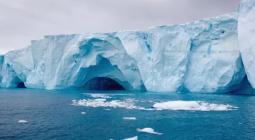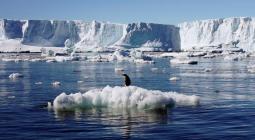Without the Southern Ocean we cannot survive on Earth. Our research must wait no longer

We’re racing to keep up with the pace of change as a future arrives faster than we predicted
To protect Antarctica and the Southern Ocean is to protect humanity’s future on this planet.
That may sound overdramatic – until you appreciate this region’s crucial role in the global climate system.
The Southern Ocean is the pump that ventilates most of the world’s deep oceans. It nurtures unique wildlife and feeds fisheries and stores carbon and absorbs heat. Without its free services, the planet would be unliveable for us.
The ice sheet covering east Antarctica holds most of the Earth’s glacier ice, with enough potential sea-level rise to, if it melted, utterly transform our coastline and engulf our cities.
Every fraction of a degree of warming, every tonne of carbon emitted, matters. This is the critical decade for decisions to avoid tipping points in Antarctica and the Southern Ocean that affect the entire world.
The mission of the Australian Antarctic program partnership at the University of Tasmania is to undertake collaborative science that informs timely policy responses to climate change.
We need every opportunity to get ships on the Southern Ocean, probes under ice shelves, sensors on to seals, instruments into the water and satellites over sea ice to get the information needed.
If all went according to plan, right now Australia’s icebreaker RSV Nuyina would be a floating laboratory gliding through sea ice off the Antarctic coast on a 60-day science mission.
There would have been more than 50 Australian and international scientists measuring under, inside and above the ice to understand how the ocean, ice and atmosphere are interacting.
In the winter just gone, when an area larger than Western Australia failed to freeze, we would have been bearing witness to what we suspect is a significant “regime shift” in the Southern Ocean.
But plans changed, the ship was not available and the voyage was cancelled.
The last time Australia had scientists on the sea ice in east Antarctica was 10 years ago. Now, as satellites monitor the most drastic changes since records began, we need to be sure we can get boots in the snow for future years.
Such essential research should not be cancelled or deferred indefinitely. It’s urgently needed. We can’t afford to be taken by surprise by abrupt changes in such a reliable seasonal cycle and important life-support system as the annual freeze and melt of Antarctic sea ice.
One icebreaker doubling as a cargo ship is not enough for the scale of scientific research required.
These were some of the issues discussed at the public hearings of the Senate inquiry into Australian Antarctic Division funding.
Many submissions expressed the frustrating urgency of the situation we find ourselves in – while rapid climate-related shifts are happening in Antarctic and Southern Ocean systems, we’re unable to properly observe them and figure out what’s going on.
A global conference in Hobart of 300 scientists from 25 nations pointed out that “the chronic lack of observations for the Southern Ocean challenges our ability to detect and assess the consequences of change”.
Hobart-based scientists are world leaders in knowledge about all kinds of Antarctic ice and their roles – the mobile ice pack, the landfast ice and ice shelves attached to the coast, which buttress the thick ice sheet and glaciers on land and hold back sea-level rise.
For decades our work has been influential in the deliberations of the Intergovernmental Panel on Climate Change and the development of targets to limit warming below 2C.
We’re racing to keep up with the pace of change and ensure we understand the magnitude of impacts for a future arriving faster than we predicted.
In November some of our oceanographers will set sail on the CSIRO research ship RV Investigator for the Antarctic circumpolar current. This is the strongest current on Earth, swirling around Antarctica to form a boundary between warm northern and cold polar waters that blocks heat from being carried polewards.
While the voyagers measure the properties of the ocean inside the current, a satellite will measure the surface from space, to explore how “gateways” in the current allow heat to leak through and melt the ice.
Our glaciologists are part of the field camp at Denman glacier this summer, to examine what’s happening on both the floating ice shelf and in the ocean underneath.
And early next year a two-month voyage will travel to the edge of the Antarctic ice to investigate the Southern Ocean as a climate influencer from all angles, from the productivity of its plankton to the formation of clouds.
It looks as though the Southern Ocean is shifting gear but we don’t yet know where it’s heading and what that means for us. That’s where our research comes in.
But we do know that the only way to maintain the cryosphere – the frozen parts of Earth – is to urgently reduce greenhouse gas emissions and stop global heating.
-
Prof Nathan Bindoff is a physical oceanographer and coordinating lead author of Intergovernmental Panel on Climate Change reports. He leads the Australian Antarctic program partnership at the University of Tasmania
Photograph: John Weller/AFP/Getty Images - ‘The ice sheet covering east Antarctica holds most of the Earth’s glacier ice, with enough potential sea-level rise to, if it melted, utterly transform our coastline and engulf our cities.’





